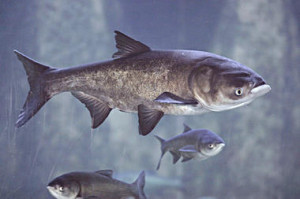Asian Carp DNA Detected in Lake Michigan Sample
Daily News Article — Posted on November 7, 2013

Asian bighead carp
(by John Flesher, ABC News) AP – A water sample from Lake Michigan’s Sturgeon Bay in Wisconsin has tested positive for DNA from invasive Asian carp, although it’s unknown whether the genetic material came from a live fish, scientists said Tuesday.
It’s the second positive DNA hit for the feared carp detected in Lake Michigan in recent years, as experts work to determine how far the voracious fish have advanced toward the Great Lakes. (Read more under “Background” below.) A water sample taken in 2010 from the lake’s Calumet Harbor also yielded a positive result.
Four types of Asian carp imported decades ago have escaped into the wild and migrated northward in the Mississippi River and many of its tributaries. (See map under “Resources” below) Of particular concern are bighead and silver carp, which gobble huge amounts of plankton – microscopic plants and animals that are essential for aquatic food chains. Scientists fear if they reach the Great Lakes, they could out-compete native species and threaten a fishing industry valued at $7 billion.
An electric barrier in a shipping canal 37 miles from Chicago is meant to block their path toward Lake Michigan. Just one live Asian carp has been found beyond that point, although numerous DNA samples have turned up past the barrier and in Lake Erie.
Scientists say fish DNA is found in mucus, scales and bodily wastes they discharge. But some say there could be other sources, such as droppings of birds that have eaten the fish, so it isn’t certain that the Sturgeon Bay discovery signals the presence of live Asian carp, much less a breeding population.
“It’s hard to know what to make of it,” said Mike Staggs, director of fisheries management with the Wisconsin Department of Natural Resources.
The samples were collected and analyzed by researchers with the University of Notre Dame, Central Michigan University and The Nature Conservancy as part of a broader Great Lakes fish survey. Fifty samples were taken from Sturgeon Bay in May, but the finding that one carried silver carp DNA was confirmed only last week.
The Wisconsin DNR and the U.S. Fish and Wildlife Service will take more samples from the area in hopes of determining whether the positive hit was a fluke or something worse.
“One sample is a smoke detector,” said Chris Jerde, a Notre Dame biologist. “A couple of more samples is a fire.”
It’s too early to be alarmed, but the finding is “an interesting development that we need to research further,” said Brian Elkington, a deputy supervisor with the Fish and Wildlife Service regional office in Minneapolis.
Sen. Debbie Stabenow, a Michigan Democrat, said the result underscores the need for the U.S. Army Corps of Engineers to expedite proposals for permanently shielding the Great Lakes from Asian carp. The Corps is wrapping up a report scheduled for release early next year.
“These fish could destroy the Great Lakes ecosystem, as well as boating and fishing industries and hundreds of thousands of jobs,” Stabenow said.
Reprinted here for educational purposes only. May not be reproduced on other websites without permission from The Associated Press. View the original article at ABCNews.com.
Questions
1. What has been discovered in a water sample taken from Lake Michigan's Sturgeon Bay in Wisconsin this year?
2. Why has a group of researchers been conducting a Great Lakes fish survey? Be specific.
3. Why is this discovery of concern?
4. Why might this particular discovery not be as big a problem as it is feared to be?
5. How does Brian Elkington of the Fish and Wildlife Service regional office in Minneapolis view the discovery?
6. What concern does Sen. Debbie Stabenow, Michigan Democrat have about the discovery? What does she say should be done about it?
7. Which of the following idioms best sums up what can be learned from the potential destruction the Asian carp might cause?
a) Hindsight is 20/20
b) You can’t judge a book by its cover
c) A bird in the hand is worth two in the bush
d) Hit the nail on the head
e) Big fish in a small pond
Background
Asian carp were imported into the U.S. in the 1970s to filter pond water in fish farms in Arkansas. Flooding allowed them to escape and establish reproducing populations in the wild by the early 1980s. At present, bighead carp have been found in the open waters of 23 states and silver carp in 17 states. Asian carp represent over 97% of the biomass in portions of the Illinois and Mississippi Rivers and are swiftly spreading northward up the Illinois River in the direction of the Great Lakes. (Read more at: nwf.org/Wildlife/Threats-to-Wildlife/Invasive-Species/Asian-Carp.aspx)
